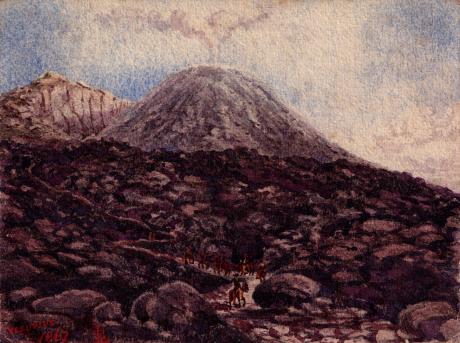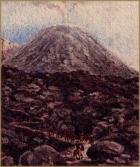inscribed on the reverse " Forms unfashioned fresh from Natures hand / Goldsmiths Travel / (Vesuvius: Path over the old Lava / 1867 ) April 1873"
Mount Vesuvius also 'A muntagna or 'A montagna; Vesuvius also Vesevius, Vesvius or Vesbius is a somma-stratovolcano located on the Gulf of Naples in Campania, Italy, about 9 km (5.6 mi) east of Naples and a short distance from the shore. It is one of several volcanoes which form the Campanian volcanic arc. Vesuvius consists of a large cone partially encircled by the steep rim of a summit caldera caused by the collapse of an earlier and originally much higher structure.
The eruption of Mount Vesuvius in AD 79 destroyed the Roman cities of Pompeii, Herculaneum, Oplontis and Stabiae, as well as several other settlements. The eruption ejected a cloud of stones, ashes and volcanic gases to a height of 33 km (21 mi), erupting molten rock and pulverized pumice at the rate of 6×105 cubic metres (7.8×105 cu yd) per second. More than 1,000 people are thought to have died in the eruption, though the exact toll is unknown. The only surviving eyewitness account of the event consists of two letters by Pliny the Younger to the historian Tacitus.
Vesuvius has erupted many times since, and is the only volcano on the European mainland to have erupted within the last hundred years. Today, it is regarded as one of the most dangerous volcanoes in the world because of the population of 3,000,000 people living near enough to be affected by an eruption, with 600,000 in the danger zone, making it the most densely populated volcanic region in the world, as well as its tendency towards violently explosive eruptions, which are now known as Plinian eruptions.
Mount Vesuvius has erupted many times. The eruption in AD 79 was preceded by numerous others in prehistory, including at least three significantly larger ones, including the Avellino eruption around 1800 BC which engulfed several Bronze Age settlements. Since AD 79, the volcano has also erupted repeatedly, in 172, 203, 222, possibly in 303, 379, 472, 512, 536, 685, 787, around 860, around 900, 968, 991, 999, 1006, 1037, 1049, around 1073, 1139, 1150, and there may have been eruptions in 1270, 1347, and 1500. The volcano erupted again in 1631, six times in the 18th century (including 1779 and 1794), eight times in the 19th century (notably in 1872), and in 1906, 1929 and 1944. There have been no eruptions since 1944, and none of the eruptions after AD 79 were as large or destructive as the Pompeian one.
The eruptions vary greatly in severity but are characterized by explosive outbursts of the kind dubbed Plinian after Pliny the Younger, a Roman writer who published a detailed description of the AD 79 eruption, including his uncle's death. On occasion, eruptions from Vesuvius have been so large that the whole of southern Europe has been blanketed by ash; in 472 and 1631, Vesuvian ash fell on Constantinople (Istanbul), over 1,200 kilometres (750 mi) away. A few times since 1944, landslides in the crater have raised clouds of ash dust, raising false alarms of an eruption.
Since 1750, seven of the eruptions of Vesuvius have had durations of more than 5 years, more than any other volcano except Etna. The two most recent eruptions of Vesuvius (1875–1906 and 1913–1944) both lasted more than 30 years.
- Vesuvius entered a new phase in December 1631, when a major eruption buried many villages under lava flows, killing around 3,000 people. Torrents of lahar were also created, adding to the devastation. Activity thereafter became almost continuous, with relatively severe eruptions occurring in 1660, 1682, 1694, 1698, 1707, 1737, 1760, 1767, 1779, 1794, 1822, 1834, 1839, 1850, 1855, 1861, 1868, 1872, 1906, 1926, 1929, and 1944.


